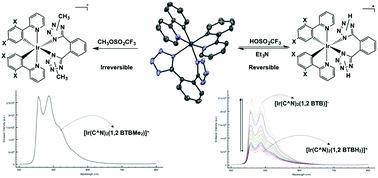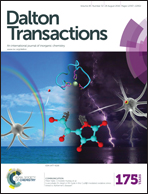Negatively charged Ir(iii) cyclometalated complexes containing a chelating bis-tetrazolato ligand: synthesis, photophysics and the study of reactivity with electrophiles†
Abstract
The bis-tetrazolate dianion [1,2 BTB]2−, which is the deprotonated form of 1,2 bis-(1H-tetrazol-5-yl)benzene [1,2-H2BTB], is for the first time exploited as an ancillary N^N ligand for negatively charged [Ir(C^N)2(N^N)]−-type complexes, where C^N is represented by cyclometalated 2-phenylpyridine (ppy) or 2-(2,4-difluorophenyl)pyridine (F2ppy). The new Ir(III) complexes [Ir(ppy)2(1,2 BTB)]− and [Ir(F2ppy)2(1,2 BTB)]− have been fully characterised and the analysis of the X-ray structure of [Ir(ppy)2(1,2 BTB)]− confirmed the coordination of the [1,2 BTB]2− dianion in a bis chelated fashion through the N-atoms adjacent to each of the tetrazolic carbons. Both of the new anionic Ir(III) complexes displayed phosphorescence in the visible region, with intense sky-blue (λmax = 460–490 nm) or aqua (λmax = 490–520 nm) emissions originating from [Ir(F2ppy)2(1,2 BTB)]− and [Ir(ppy)2(1,2 BTB)]−, respectively. In comparison with our very recent examples of anionic Ir(III)tetrazolate cyclometalates, the new Ir(III) tris chelate complexes [Ir(F2ppy)2(1,2 BTB)]− and [Ir(ppy)2(1,2 BTB)]−, display an improved robustness, allowing the study of their reactivity toward the addition of electrophiles such as H+ and CH3+. In all cases, the electrophilic attacks occurred at the coordinated tetrazolate rings, involving the reversible – by a protonation deprotonation mechanism – or permanent – upon addition of a methyl moiety – switching of their global net charge from negative to positive and, in particular, the concomitant variation of their photoluminescence output. The combination of the anionic complexes [Ir(F2ppy)2(1,2 BTB)]− or [Ir(ppy)2(1,2 BTB)]− with a deep red emitting (λmax = 686 nm) cationic Ir(III) tetrazole complex such as [IrTPYZ-Me]+, where TPYZ-Me is 2-(2-methyl-2H-tetrazol-5-yl)pyrazine, gave rise to two fully Ir(III)-based soft salts capable of displaying additive and O2-sensitive emission colours, with an almost pure white light obtained by the appropriate choice of the ionic components.


 Please wait while we load your content...
Please wait while we load your content...